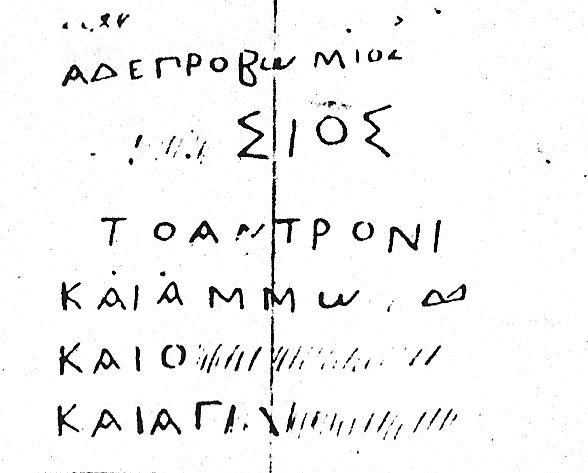EpiDoc XML:
IGCyr0329002
Trismegistos ID:
738322
Source description
Support: Cut in the North wall of a rock-cut chamber (dimensions unknown).
Layout: Inscribed at least three times.
Letters: Hand 1: height unknown; nothing is known about this hand. Hand 2: height unknown; larger letters than hand 3; slanting sigma. Hand 3: height unknown; dropped bar alpha, tall beta, lunate omega and epsilon or sigma.
Date: Textpart a: probably second half of the fourth century BC; b.2: perhaps third century BC; b.1 and 3-6: perhaps first century BC (context, lettering).
Findspot: Copied between 1919 and 1922 by S. Ferri in Cyrene ➚: East Necropolis tomb E24, belonging to the area of Ain Hofra.
Place of origin: Findspot.
Last recorded location: Seen by the Chieti mission (O. Menozzi) between 2002 and 2005 in situ at Ain Hofra. Seen and photographed in 2009 by S. Marini. Not seen by IGCyr team.
Text constituted from: Transcription from Ferri's copy, with support of Menozzi's description and Marini's photograph (CDL).
Bibliography
Ferri 1923, n. 19, whence SEG, 9.345; Menozzi 2008, pp. 41-42, fig. 15; IGCyr 032900 ➚. Cf. Forbes 1956, whence SEG, 16.872; Menozzi 2015, pp. 64-67, fig. 8; Marini 2018, pp. 227-228, pl. XVb, whence SEG, 65.2024.
Text
Apparatus
a: read from Menozzi's diplomatic transcription; not seen by others
b.1: Ἅδε̣ προβώμιος: ἅδε προβώμιος Ferri 1923
b.2: Λ̣ύσιος: [---]σιος Ferri 1923
b.4: Ἀμμω̣ν̣[ί]ω̣: Ἀμμω[.]+ SEG
French translation
a) ⟦(scil. Lieu de culte) des Héros, de Zeus. Euménides⟧.
b) «[---] en avant de l'autel. A Lysis (scil. appartient) cette grotte ainsi qu'à Ammônios, à O[---] et à Ag[---]».
English translation
a) ⟦(scil. Cult area) of the Heroes, of Zeus. Eumenides.⟧
b) «[---] before the altar. Belonging to Lysis (scil. is) this cave as well as to Ammonios, to O[---] and to Ag[---]».
Italian translation
a) ⟦(scil. Luogo di culto) degli Eroi, di Zeus. Eumenidi.⟧
b) «[---] davanti all'altare. Appartenente a Lysis (scil. è) questa grotta come pure ad Ammonios, ad O[---] e ad Ag[---]».
Commentary
The complex history of the different stages of this inscription is much confused. We follow Menozzi's chronology, although it is not clear whether a) was really cut at the very place where b) was inscribed later on. If so, a) was first cut and erased, then b) was overstruck. However it is clear both from Ferri's description and drawing and from Menozzi's photograph that b) was cut by at least two different hands. Line 2 probably stood by itself and was later on incorporated into a larger text.
At b.1 the third letter should be an epsilon, although it seems to be incomplete. If the reading is right the demonstrative at the feminine singular would be related to a subaudible θυσία, as we know from IGCyr0167002, ll. 61 and 68, that some sacrifices should be done 'in front of the altar'.
About the three lower lines Ferri gave neither transcription nor comment. The assumption that Ammon was worshipped here (so Fabbricotti 2007, p. 100 and again Menozzi twice) seems to be a misinterpretation of part of line b.4: we consider much probable that the three personal names, each of them preceded by καί, were added under the previously inscribed name while line 1 was added above. If so, it allows to read the successive lines as a whole. Our translation relies on that assumption. Menozzi's latest analysis (Menozzi 2015) would read the three καί in relation with the erased divine names, which is impossible in view of the lettering.
The present reconstruction, although provisional, would be consistent with the history of the tomb/cave as constantly proposed by Menozzi.
CC BY-NC-SA 4.0 Deed Attribution-NonCommercial-ShareAlike 4.0 International License.
All citation, reuse or distribution of this work must contain a link back to DOI: https://doi.org/10.60760/unibo/igcyrgvcyr2 and the filename (IGCyr000000 or GVCyr000), as well as the year of consultation.


